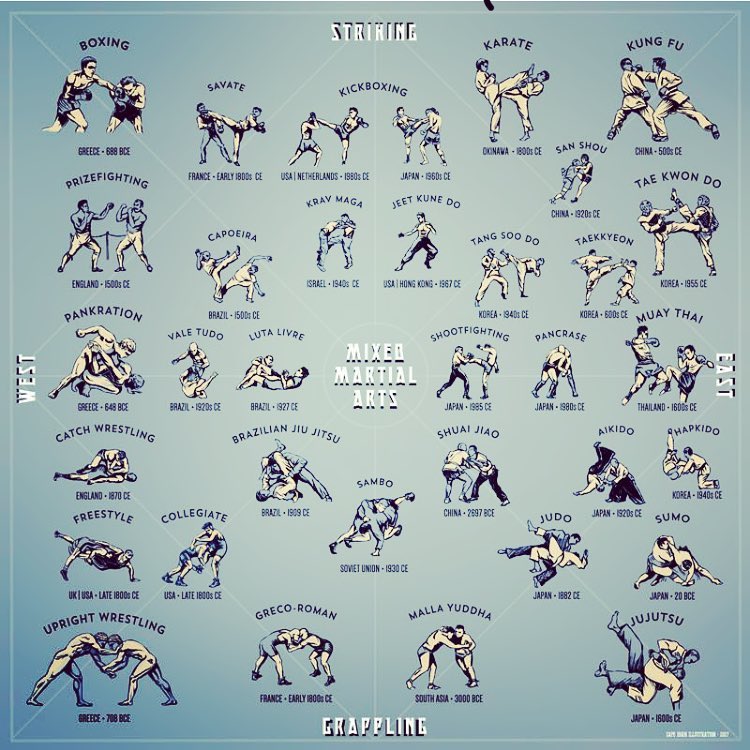The Background And Ideology Of Fighting Style: A Deep Dive
The Background And Ideology Of Fighting Style: A Deep Dive
Blog Article
Authored By-McGrath Stokes
Step into the old globe where martial arts were born out of necessity in varied areas. Cultures crafted special combating styles intertwined with historic contexts. when to get kids into martial arts evolved over centuries with committed technique and social exchanges. Today, contemporary martial arts blend standard elements for optimal effectiveness. Philosophically, martial arts emphasize technique, self-improvement, and harmony. why martial arts is bad , humility, and balance are foundational principles guiding practitioners towards growth and durability. Check out the midsts of this abundant history and viewpoint to uncover the profound impacts shaping this long-lasting self-control.
Origins of Fighting Style
Martial arts came from numerous areas around the globe, evolving as practical combat systems to prevent threats. These old combating designs were created out of requirement, with each society crafting techniques matched to their distinct environments and difficulties. From the grappling arts of Jujutsu in Japan to the striking methods of Martial art in China, martial arts were deeply linked with the historic, social, and social material of their corresponding societies.
In Japan, the samurai course polished martial arts like Kenjutsu, the art of the sword, which later on developed right into the a lot more promoted type of Kendo. At the same time, in Brazil, Capoeira became a mix of dancing and battle, produced by enslaved Africans as a method to withstand oppression. Each martial art lugs with it a rich background and philosophy, showing the worths and beliefs of individuals that practiced them.
As you explore the beginnings of martial arts, you discover a tapestry of human resourcefulness, resilience, and the unrelenting spirit of warriors throughout time.
Development of Strategies
With centuries of practice and improvement, combat techniques within various martial arts have actually gone through an extensive development. From relevant web page like Martial art and Martial arts to extra contemporary disciplines such as Brazilian Jiu-Jitsu and Krav Maga, the development of methods has actually been driven by a combination of social impacts, useful applications, and technological improvements.
One substantial aspect of this advancement is the cross-pollination of methods in between different martial arts. For instance, techniques from traditional Japanese Jiu-Jitsu were integrated into the production of Judo by Jigoro Kano in the late 19th century. This blending of styles has actually caused the development of crossbreed martial arts like Mixed Martial Arts (MMA), which combine elements of striking, grappling, and submission methods.
Moreover, the evolution of strategies has been formed by the boosting focus on effectiveness and effectiveness in combat. Professionals have continuously sought to improve their methods via strenuous training, experimentation, and competition, leading to the development of highly specialized and efficient combating designs. Overall, the advancement of strategies in martial arts reflects the vibrant nature of combat and the recurring pursuit for enhancement and innovation.
Philosophical Structures
Discovering the underlying philosophical concepts of martial arts supplies insight into their core worths and assisting beliefs. At the heart of several martial arts techniques is the principle of technique itself. By training your mind and body to act as one natural system, you cultivate technique that expands past the dojo or health club right into everyday life. https://www.paralympic.org/feature/sport-week-welcome-para-taekwondo -control incorporates regard, humbleness, and self-constraint, shaping not simply your physical capacities however likewise your personality.
An additional basic thoughtful structure in martial arts is the idea of continual self-improvement. The journey of mastering a martial art is never-ending, with specialists constantly aiming to much better themselves, both physically and emotionally. This focus on growth cultivates durability, willpower, and a development mindset that can be put on all aspects of life.
In addition, martial arts emphasize the value of harmony and equilibrium. Techniques are designed to utilize an opponent's energy versus them, highlighting the concept of producing and redirecting pressure as opposed to fulfilling it head-on. This philosophy includes interpersonal partnerships, promoting relaxed resolutions and mutual understanding. By embracing these thoughtful structures, martial musicians not just improve their combat abilities yet likewise cultivate a way of living centered on personal growth, regard, and harmony.
Conclusion
Finally, the history and philosophy of martial arts use a rich tapestry of practice, technique, and self-improvement.
Consider example the tale of Bruce Lee, who changed martial arts by blending different designs and approaches to develop his very own unique form of Jeet Kune Do.
Through devotion and advancement, martial musicians continue to press borders and influence others to reach their full potential both in combat and in life.
